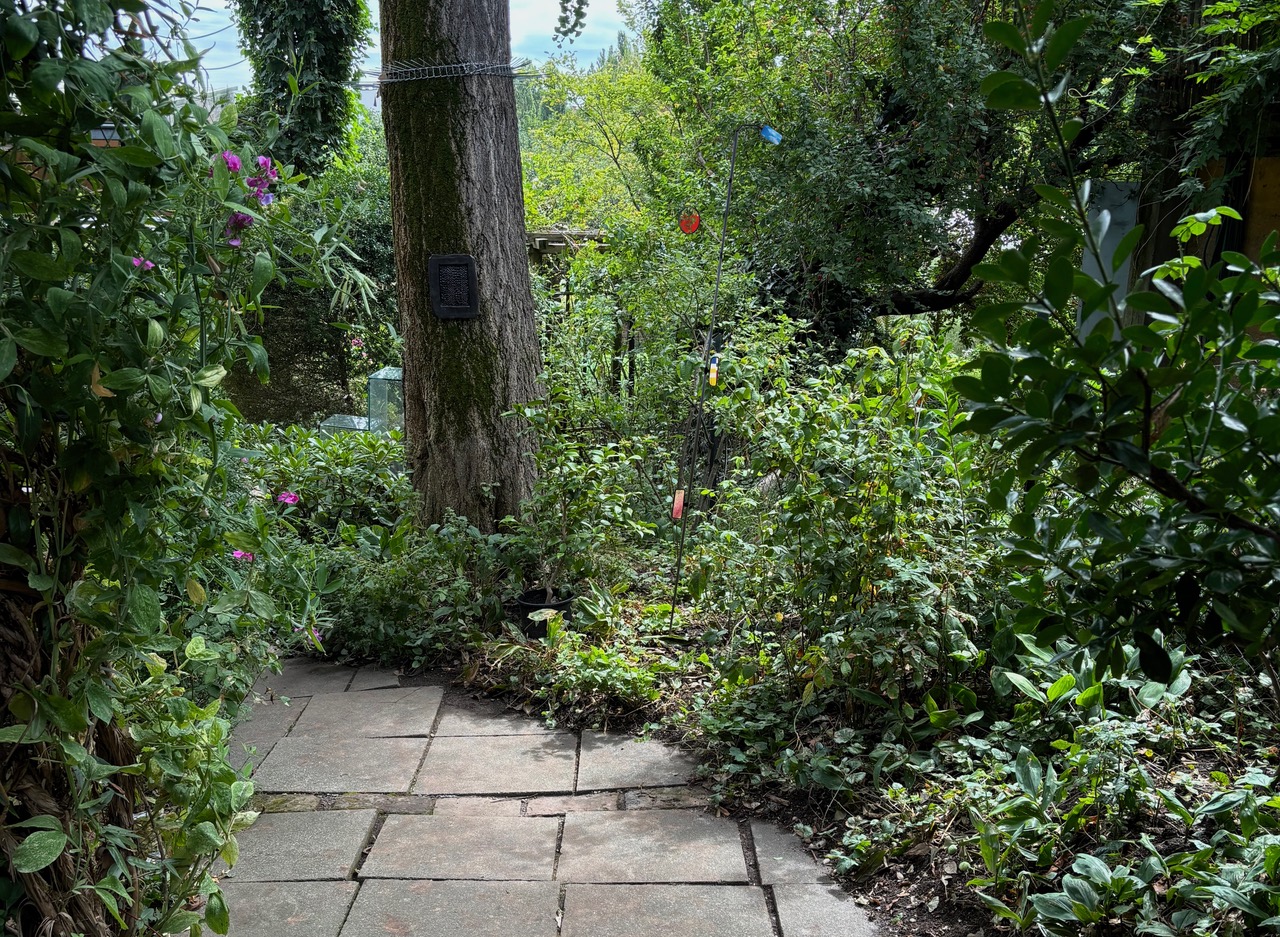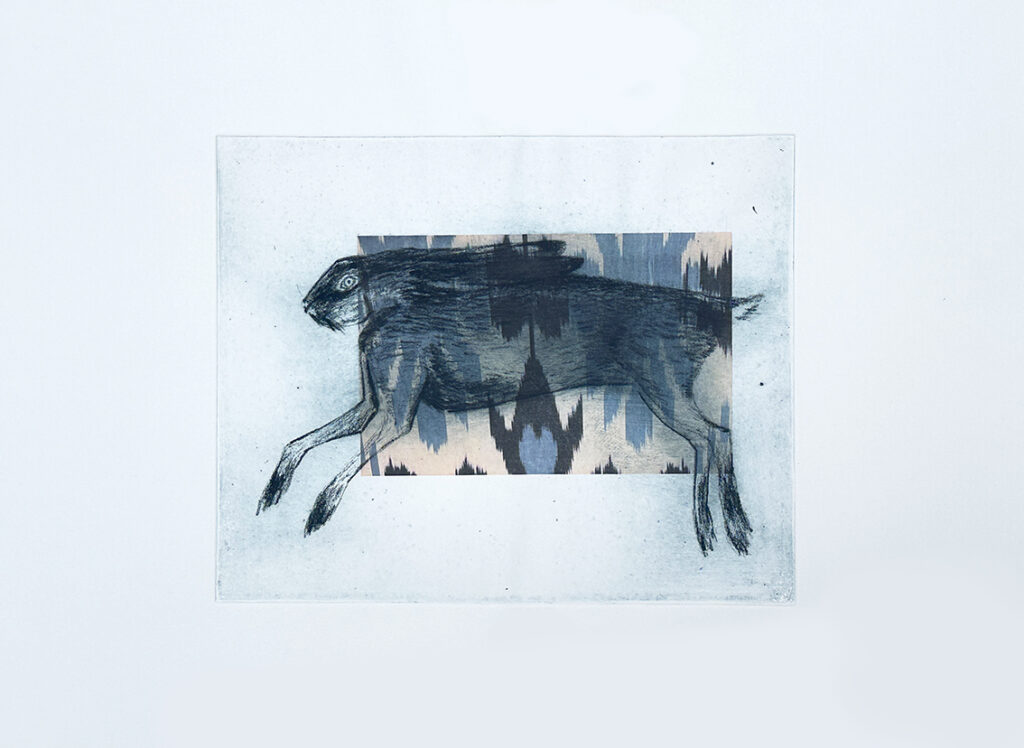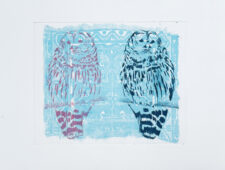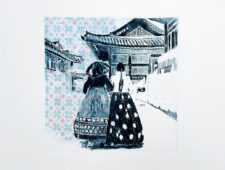Agnes Christine Katschner Im Schatten, 2024 Polymerdruck mit Chine-collé, EA, 20 x 25 cm, gerahmt: 47 x 57 cm EA, 2024
HUGS
Agnes C. Katschner, Ada Kobusiewicz, Roosvita St.A.i.R. (Styria-Artist-in-Residence) bei KiG! Kultur in Graz) & Linda Maria SchwarzÂ
Duration of exhibition: 7. September – 1. October
Curator: Irmi Horn
Opening: Mag. pharm. Michael Rothe (district leader district leader Graz-Gries) – & art historian Elisabeth Passath, MA
When a pack of hyenas hugs at night to sleep and cuddles up to each other, a feeling of the familiar, protected, warming probably arises. It seems to be an inherent need to celebrate this peaceful coexistence like a redemption ceremony at the end of the day.
At the same time, this unconditional devotion, this trust in the group is also a phenomenon that manifests a dependence.
If we transfer this fact of the desire for peaceful security, tender attention, in the broader sense of understanding and loyalty to people, it can lead to dependence up to submission.
Thus, in dogmatic political processes, especially those based on divine laws, a complete task of critical thinking can take place and subsequently a division of society can be initiated, which leads to hatred and exclusion.
Agnes C. Katschner
Agnes C. Katschner
Embrasser la face cachée
“The most terrible thing is to accept yourself completely” (C. G. Jung)
These works are about the examination of one’s own personality, the dichotomy of light and dark aspects, which according to the psychoanalytic theory of C. G. Jung are considered essential and signs of the vitality of human existence. The acceptance and, as it were, embrace of the dark sides of the personality represents a challenge and is associated with culturally determined values. Verena Kast describes Jung’s concept of shadow as elementary for people’s coexistence, especially with regard to ethics and morality. “Those who can accept themselves better are more empathetic, more creative in dealing with everyday problems. In addition, it is noticed that the encounter with the inner world is still additionally interesting, that a pattern of life is emerging, life is becoming rounder and rounder.” (Verena Kast, The Depth Psychology according to C.G. Jung, 2007)
The images of the exhibition are about a connection between the unconscious and consciousness, about constructive and destructive behaviors and their forms of expression in dreams, especially with regard to the ambivalence of distance and closeness.
Agnes Christine Katschner
Your contribution – developed for this for the exhibition “Huggings” – consists of 2 pictures, mixed media/ wood (60 x 60 cm) and 4 prints of 40 x 30 cm framed (50 x 40 cm), etching/polymer printing.
- Zwischen den Welten II
2024, Polymerdruck, 20 × 25 cm, gerahmt: 47 × 57 cm
- sont liés, 
2024, Polymerdruck mit Chine-collé, 30 × 30 cm, gerahmt: 47 × 57 cm, EA
- Agnes Christine Katschner Im Schatten, 2024 Polymerdruck mit Chine-collé, EA, 20 x 25 cm, gerahmt: 47 x 57 cm EA, 2024
Agnes Christine Katschner
Biography: Studies at the University of Applied Arts in Vienna and at the University of Vienna
Studies abroad in Utrecht (NL) and Leeds (GB)
Teaching assignment for art history and representation/composition at the HTBLVA for art and design, Ortweinschule Graz
Numerous exhibitions since 2006.
Ada Kobusiewicz was born in Poland. In 2004 she moved to Spain, where she studied at the University of Granada at the Faculty of Philosophy and Art, as well as at the Andalusian Institute of Arts, where she was mainly involved in lighting design. In 2012, she completed her studies in art, research and production at the Art Academy in Granada and received her Master of Arts in Novisad, Serbia, in lighting design. Since April 2014, she has been writing her PhD in “Research in Art” at the Basque University in Spain. She exhibits in Austria, Spain, Serbia, Italy, Croatia, Bosnia and Herzegovina, Finland and the UK; her work has been at festivals in the USA, Sweden, England, Austria, Serbia, France, Portugal, Germany, Mexico, Spain, Greece, South Korea and Poland. She lives and works in Spain, Austria, Serbia and Poland.

Ada Kobusiewiz RĂśCKBLICK 2024, Installation
Ada Kobusiewicz presents with BLICK, an installation on stainless steel tube with car rear-view mirrors, an intervention for viewers. It creates the connection to subjective and collective memory through the material, offers a drop on the memory network of history: the haptic moment, the physical, the craftsmanship, the sense of touch, the skin finally.
Roosvita
In a critically humorous way, she will approach the term embrace with two installations.

Linda Maria Schwarz
Stillleben in Bronze: Der Reigen, 2020;
125x25x25 cm
Bronze, 82 kg
Linda Maria Schwarz was born in Arnfels/Styria.
She received her diploma in sculpture at the Master School of Art and Design,
Ortweinschule/Graz and lives and works in Styria.
This artist also creates an outer to an interior and refers to protection and limitation.
Linda Maria Schwart explores everyday processes in order to find the extraordinary in the often seemingly banal everyday life. We are faced with the difficulty of understanding everyday life. He is, as Rita Felski writes, “at first glance […] everywhere and yet nowhere.” Consequently, its importance as an expression of certain power structures is quickly underestimated or overlooked. So what happens when everyday life becomes art? When everyday life is no longer seen as a filler between the great events of life and the “everyday” things get enough meaning to be art themselves? After the art at the beginning of the 19th Century of royal and papal influence, the question arose as to how she should relate to everyday life. The views range from the demand for a commitment of art in society to the desire for complete autonomy of art (l’art pour l’art). This goes as far as the view that, as Beuys used to say, everyone in everyday life is an artist.
Through the surprisingly everyday material in her works, Linda Maria Schwarz refers abstractly to the critical content of her art – the everyday life of a woman and not least to that lived by herself.
The works of art are souvenirs from everyday life, which are raised in the – literally understood – state of splendor of a bronze sculpture.
Elisabeth Zuparic-Bernhard
Scientific assistant to the management at the Center for Contemporary Art and
Employee at the Institute of Art History at the Karl-Franzens-University Graz
SHORT BIO




